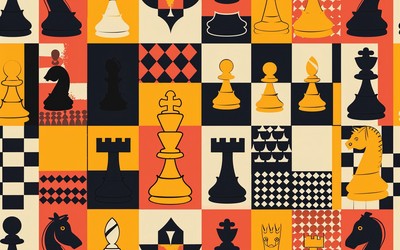
Midjourney
Understanding Risk in Chess
How this underrated concept can transform your gameToday I want to talk about an idea that is rarely discussed in chess strategy books, but forms an important part of the thought process for strong players. That idea is risk.
For a while I was taking online lessons with GM Krasimir Rusev. (I think I’ve used this example before, but it’s relevant to the topic.) I had this position against a talented and dangerous junior, Martha Samadashvili. I won a pawn in the opening, but she tried to get counterplay by posting her bishop on the long diagonal opposite my rook.
Here I was choosing between Rb1, getting off the diagonal, or continuing development with Nf3. In the game I thought for a long time making sure all the lines worked for me after Nf3, but in the end chickened out and played Rb1 anyway. Afterwards when I checked with the engine, it turned out I had calculated the lines correctly and the engine preferred Nf3. My takeaway was that I should trust my calculations and not make decisions out of fear. But when I showed the game to Krasi he had a different take.
“I would play Rb1 quickly.”
I showed him all the lines proving I could get away with Nf3.
“Yes, but if you’re wrong you lose, and after Rb1 you have a good position anyway.”
The reason this was such a memorable moment for me – and why I’m using the story again – is it was the moment I realized that what sets GMs apart is not only the ability to calculate more accurately, but understanding when to calculate – and when not to.
In this position, it is possible to get away with leaving the rook on the long diagonal, but it is easier and safer to move it and avoid the potential for tactics entirely. This also has the side benefit of allowing you to play faster, because you don’t have to calculate as much. And if you choose to leave that rook on a1, you will have to calculate all the lines all over again every move until you move it.
Now let’s look at a position from a game Chess Gym member Kevin Scull recently posted. (If you’d like to analyze your games with other players who are trying to improve, check out The Chess Gym. We recently added a free one week trial membership!)
Kevin as Black was up two pawns but facing some pressure in the center. He decided to go for the forcing line 22... dxc4 23. Nxc4 Rd8 24. Nd6+ Rxd6 25. Qxd6 Qxb5 leading to this position.
Here he was expecting 26. Rd1, which he was planning to meet with Nd7, but White surprised him with 16. Rc1, creating a difficult-to-answer threat of Rc8#. Actually, Black can still defend in this position, and the game swung back and forth several times afterwards, but certainly Black’s position has become difficult.
So what’s the takeaway here? That Black missed an important move on move eight of the variation? That would be one way of looking at it, but it wouldn’t be mine. Because while the exact move is hard to see ahead of time, there are many factors that suggest this line could be dangerous for Black:
- Long variation (“long variation, wrong variation”)
- Many choices for the opponent: White’s moves aren’t forced.
- Black’s king is exposed.
- Lack of development: the knight and rook are stuck on the back rank.
In a sense, it’s less important that the line doesn’t work, than that it shouldn’t work. And indeed, in addition to 26. Rd1, White can also force a draw immediately with 26. Qb8+ Ke7 27. Qd6+ etc., so if you believed Black was better at the beginning of the line, that’s another problem.
Let’s go back to the initial position. Were there any other options?
Yes, absolutely. Black is two pawns up and White doesn’t have an immediate threat, so the priority should be finishing development and getting the king to safety. Black could play Ng6 or Nd7 intending to castle next move. It is difficult for White to do much against this plan. So in my view, the real mistake wasn’t calculating inaccurately, it was choosing a line that relied on deep and accurate calculation when simpler and safer alternatives were available.
I’ve been noticing this pattern in many players’ games recently: the player takes many big risks throughout the game. For a while, they get away with them, but then one backfires. They come away thinking the mistake was a miscalculation in the line that finally costs them the game. But if you make many decisions that could lose the game on the spot, it should not be a surprise when one does.
So along with becoming a more accurate calculator, think about how you could use calculation more sensibly:
- When a good and simple option is available, choose that over complicated options.
- Risk must be balanced with reward: If you are taking a big risk, does it come with an appropriate reward?
- Look for warning signs like long, unforcing lines, lack of development, or exposed king. If these are present, there is always a significant risk of losing to a move you missed.
Want to simplify your chess training? Check out The Chess Gym, my online chess learning community, where we focus on the most impactful techniques for leveling up your game.




